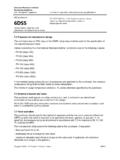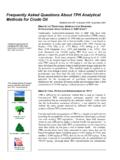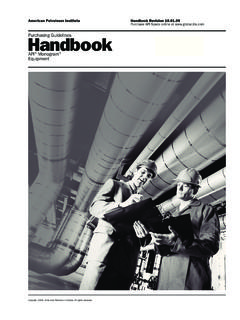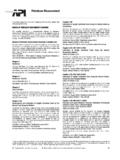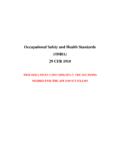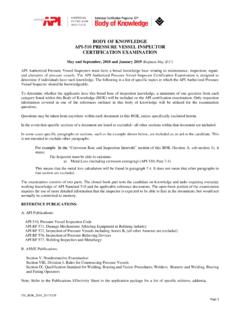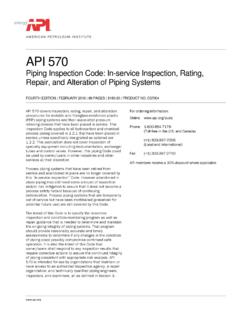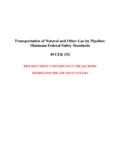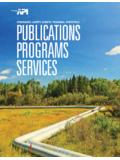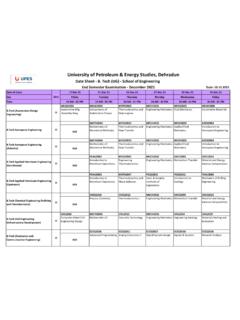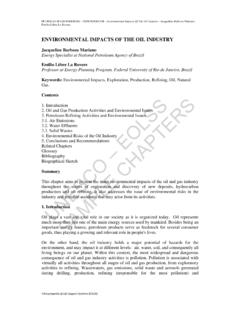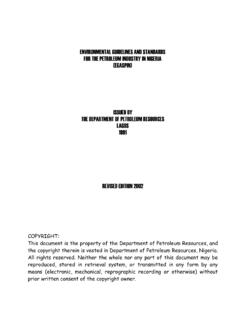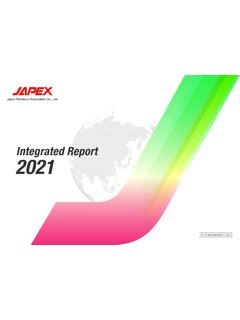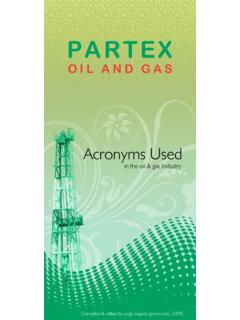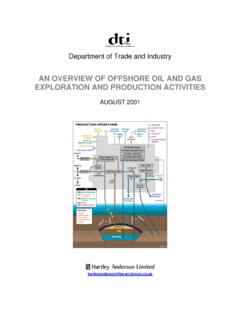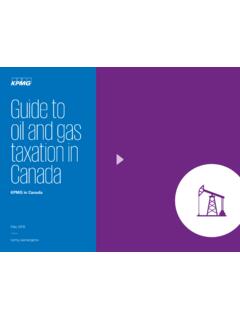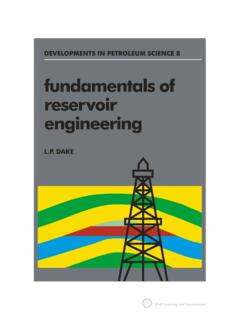Transcription of Estimating petroleum industry value chain (Scope 3 ...
1 Estimating petroleum industryvalue chain (Scope 3)greenhouse gas emissions Overview of methodologiesClimate changeTHE GLOBAL OIL AND GASINDUSTRY ASSOCIATIONFOR ENVIRONMENTAL ANDSOCIAL IPIECA/API 2016 All rights part of this publication may be reproduced, stored in a retrieval system, or transmitted in any form orby any means, electronic, mechanical, photocopying, recording or otherwise, without the prior consentof reproduced courtesy of the following: cover (top): BG Group, left: BP, centre and lower ; page 5: BG Group; pages 6, 7, 16, 17, 19, 63 and 67 : ; page 9: BP. LEGAL NOTEThis document is designed to serve as a background resource for interested companies. The terms anddefinitions used in this document are not necessarily the same as terms and definitions used in variousstatutes, rules, codes or other authoritative legal documents.
2 Users and readers of this documentshould refer to relevant legal sources or consult their own legal counsel for explanations as to how theterms and definitions used in this document may differ from the legal terms and definitions used intheir particular areas of operation. It should not be implied that the methods described in thisdocument are required to be followed for any national, local or other law. Furthermore, it is notintended to serve as a substitute for existing public reporting requirements and regulations. Anycompany reporter that has a question as to whether or not reports that follow the informationcontained herein will meet any specific reporting requirements applicable to their particular operationsshould consult with the reporter s own legal cautionary note regarding performance indicatorsAggregated, company-level, non-financial performance data, developed using this document, can beinformative, but significant limitations exist due to various factors including the high degree ofuncertainty in the base information and estimation methods available for Scope 3 GHG users are advised to exercise caution when using data from voluntary GHG emissions reports tocompare performance.
3 Where this document mentions comparability, it is not intended to imply thatdata in GHG emissions reports, and therefore companies performance, are always directly is especially important when considering Scope 3 emissions document was prepared by the IPIECA Scope 3 Reporting Task Force under the auspices of theClimate Change Working Group. IPIECA gratefully acknowledges the assistance of Lisa Grice (RambollEnviron), the principal author, in its petroleum industryvalue chain (Scope 3)greenhouse gas emissions Overview of methodologies14th Floor, City Tower, 40 Basinghall Street, London EC2V 5DE, United KingdomTelephone: +44 (0)20 7633 2388 E-mail: Website: global oil and gas industry association for environmental and social issuesThe American petroleum Institute1220 L Street NW, Washington, DC 20005-4070, USAT elephone: +1 202 682 8000 Website: Estimating petroleum industry value chain (Scope 3) greenhouse gas emissions Overview of methodologiesSection 1: Introduction and overview7 Section 2.
4 Overview of Scope 3 emissions industry greenhouse gas 10accounting and reporting and organizational emissions over to Scope 3 Scope 3 Category Scope 3 upstream and downstream Potential double counting of 16petroleum-related the Scope 3 Materiality17 Section 3: Category-specific and broadly Prioritizing Scope 3 data collection 20and calculation Overview of quantification methods 20and data Broadly applicable emissions factor goods and Category Materiality Estimating Category Materiality Estimating and energy-related activities 30(not included in Scope 1 or Scope 2) Category Materiality Estimating transportation and Category Materiality Estimating generated in Category Materiality Estimating Category Materiality Estimating Category Materiality considerations Estimating leased Category Materiality considerations Estimating emissions41 Contents3 Estimating petroleum industry value chain (Scope 3)
5 Greenhouse gas emissions Overview of transportation and Category Materiality considerations Estimating Processing of sold Category Materiality considerations Estimating Use of sold Category Materiality considerations Estimating End-of-life treatment of sold Category Materiality Estimating Downstream leased Category Materiality Estimating Category Materiality Estimating Category Materiality Estimating emissions60 Section 4: Considerations of optional assurance63 Section 5: Reporting67 References71 Glossary75 Acronyms and abbreviations79 List of figures, tables and boxesFiguresFigure 1: GHG Protocol scopes and emissions 11across the value chainFigure 2: Oil and gas industry GHG emissions 14 Figure 3: Scope 3 upstream ( purchased 15or acquired goods and services) and downstream ( sold goods and services) emissions sources by petroleum company typeFigure 4: Illustration of scope 3 upstream and 15downstream emissions sources for a refineryFigure 5: Decision tree for selecting a scope 3 21estimation methodFigure 6: Select appropriate boundary for 44 GHG emission factors associated with product processingFigure 7: Classification of Scope 3 reporting in the 69 IPIECA/API/IOGP Sustainability Reporting Guidance greenhouse gas environmental indicator (E1)List of tablesTable 1: The 15 categories of scope 3 emissions 12 Table 2: Scope 3 and petroleum industry use of 13the terms upstream and downstream Table 3.
6 Considerations for identifying relevant 18scope 3 activitiesContents4 Estimating petroleum industry value chain (Scope 3) greenhouse gas emissions Overview of methodologiesTable 4: Examples of activity estimates and 21average emissions factorsTable 5: Commonly applied third-party datasets22 Table 6: Example sources of purchased goods 23and services emissions based on company type and processTable 7: Fuels versus feedstocks scope and 23category classificationTable 8: Emission factor references for purchased 27goods and services relevant to petroleum companiesTable 9: Emission factor references for capital goods 29and equipment relevant to petroleum companiesTable 10: Emission scope and category classification 30based on source and use of fuel and electricityTable 11: Scope and category classification of 34transportation and distribution activities in the value chainTable 12: Scope and category classification of 38emissions associated with employee transportationTable 13: Scope and category classification of 41emissions for petroleum company retail operationsTable 14: Emissions included in category 10 based 43on company type and petroleum processing stageTable 15: Emission factor references for processing48 of intermediate products relevant to petroleum companiesTable 16: Emission factor references for 55fuel combustionTable 17.
7 Emission factor references for end-of-life 58disposal relevant to petroleum companiesBoxes (including case studies and calculation examples)Box 1: Typical reasons for excluding activities18 Box 2: Estimating the type and amount of 49final productsBox 3: Defining what constitutes sold products for 51integrated oil and gas companiesCase study: Estimating supply chain emissions25 Case study: Screening-level assessment of 40employee commuting emissionsCase study: Estimating emissions from 42leased LNG terminals based on capacity rights Example 1: Estimating emissions from purchased 26goods and services by using a combination of the average-data method and the spend-based methodExample 2: Estimating emissions from capital goods 29based on steel and concrete purchased for major projectsExample 3: Estimating Category 3 (fuel and 33energy)-related emissions complementary to scope 1 and 2 emissionsExample : Estimating emissions associated 45with crude oil processingExample : Estimating process beyond the refinery: 47embodied energy approachExample : Estimating use of sold products 53based on estimated final products: refineryExample : Estimating use of sold products 54based on estimated final products: exploration and productionExample : Estimating use of sold products 54based on carbon contentExample 6.
8 Estimating emissions from refinery 57products that are not sold as fuelContents5 Estimating petroleum industry value chain (Scope 3) greenhouse gas emissions Overview of methodologiesSection 1 Introduction and summaryIPIECA has developed this Overview ofmethodologies for Estimating petroleumindustry value chain (Scope 3) greenhousegas emissionsto provide information onapproaches used by oil and gas companies. 6 Estimating petroleum industry value chain (Scope 3) greenhouse gas emissions Overview of BACKGROUNDS cope 3 emissions are those generated from value chainactivities that are not accounted for and reported in thecompany s scope 1 and 2 corporate inventories. Over thepast several years, greenhouse gas (GHG) accounting andreporting has been expanding from focusing onemissions from direct operations to including GHGemissions along the corporate value chains.
9 In response to the interest in understanding GHGs alonga company s value chain , the Greenhouse Gas Protocol, amulti-stakeholder partnership convened by the WorldResources Institute (WRI) and the World Business Councilfor Sustainable Development (WBCSD), developed theCorporate value chain (Scope 3) Accounting andReporting Standard(WRI/WBCSD, 2011; referred to as the GHG Protocol Scope 3 Standard ) and the associatedTechnical Guidance for Calculating Scope 3 Emissions(WRI/WBCSD, 2013; referred to as the GHG ProtocolScope 3 Calculation Guidance ). Improving theunderstanding of GHG impacts that encompasscompany-related emissions throughout the value chainallows companies to promote improved management ofGHG-related risks and opportunities. Section 1 Introduction and summary7 Estimating petroleum industry value chain (Scope 3) greenhouse gas emissions Overview of PURPOSEThe purpose of this Overview of methodologiesis toprovide information on approaches used by oil and gascompanies to estimate and account for GHG industry -related scope 3 emission sources,category classifications and associated emissions arehighly dependent on company business models, scope 1and 2 reporting boundaries, and company operationswithin the value chain .
10 The methodologies in thisdocument outline a number of approaches used by theoil and gas industry to estimate scope 3 emissions beyond direct operations involvesan increased level of assumptions and uncertainty, andshould therefore be considered with caution. The goal ofthis Overview of methodologiesis to inform companiesabout scope 3 GHG emission estimation approaches. SCOPEThe estimation methodologies in this document focus onscope 3 emissions. It is intended to inform companies onapproaches to Estimating value - chain GHG emissions,and complement and provide oil and gas industry contextto existing standards and guidance documents includingthe following:1. GHG Protocol Scope 3 Standard (WRI/WBCSD, 2011).2. GHG Protocol Scope 3 Calculation Guidance(WRI/WBCSD, 2013).
